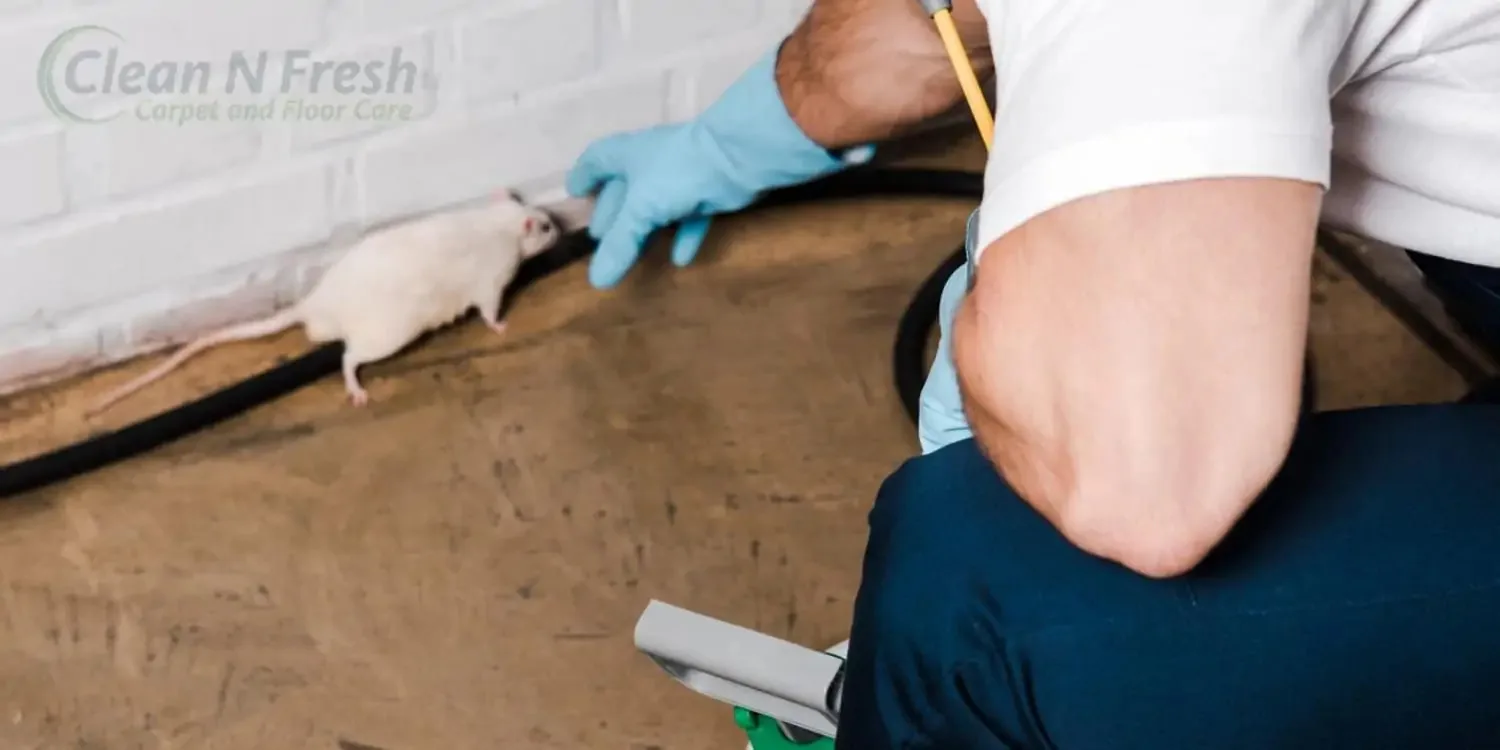Mice are known to wreak havoc. They destroy property and leave their droppings everywhere. Your carpet is no exception. Having professionally cleaned carpets and floors on Long Island for over 15 years, it’s something we’ve seen far too often.
Unfortunately, mouse droppings in themselves are the least of your worries.
Did you know those droppings also carry diseases that are detrimental to your health? They spread over 35 known diseases to humans, Hanta Virus is one of them.
So while stepping on mouse droppings on your carpet or rugs is unsightly, uncomfortable and annoying – and that’s reason enough to get rid of them – it’s imperative you know how to clean mouse droppings from your carpet after a mouse infestation because your health is at stake!
Stick with me now as I show you how to rid your home of mouse droppings. I’ll also talk about the harm they can cause so that you take cleaning up after these critters very seriously.


Avoid Hantavirus Infection by Taking These Precautions Before Cleaning Mouse Droppings
Never forget your personal safety equipment (hand gloves and dust mask) while cleaning after mice infestation. Here are some effective measures to stay safe before cleaning mouse droppings from carpet:
1. Ventilate the room
Keep all windows and doors open for at least thirty minutes before cleaning mice poop. Proper ventilation helps reduce the effects and density of the particles that will arise during the cleaning procedure. It also gives you a better breathing atmosphere.
2. Wear your gloves
Protecting your hands during the process is essential, mostly if you get irritated quickly or have an opening where the hantavirus can creep into. Use rubber, latex, or vinyl gloves.
3. Do not disturb the rat urine and droppings
Sweeping or vacuuming rodent waste only spreads the hantavirus quickly and contaminates other surfaces. Spray with a disinfectant and wait for about five minutes for it to soak in before picking with a paper towel. If this is a hard surface, you can use a bleach solution made with 90% water to 10% bleach. Do not use bleach on carpet though!
4. Seal in a plastic bag
Dispose of mice poop, rodent feces, urine and any dead rodent in a plastic bag and seal properly to prevent contaminated air from escaping and place in a trash can with a lid immediately.
5. Disinfect Carpet and upholstery and wash beddings/clothes
Since hantavirus is airborne, you’ll need to clean and disinfect your carpet and upholstery to get rid of settled particles. You should also wash exposed beddings and clothes with hot water and the 90/10 bleach solution and soap so they don’t get stirred up and get into the air again. See “How to Disinfect Carpets and Furniture“ below.
6. Wash gloves, then your hands
With the gloves still worn on both hands, wash thoroughly, then dispose of. Wash your hands after disposal too, and pat dry.
7. Double the bag for dead mice
Spray your disinfectant on dead mice and let it soak for up to ten minutes. Using a stick, collect in a dustpan and dispose in a trash bag, and put that trash bag in another.
How to Clean Mouse Droppings from Carpet
Picking
We’ll start with hand picking:
- It is cheap.
- Safe to carry out
- Requires no technical know-how
- And it’s efficient
The problem is:
- Picking is slow and time-consuming.
- It also doesn’t kill viruses and bacteria that your carpet fibers may be harboring.
- And it also requires a lot of energy and gets tiring because picking does not entail merely bending down and picking up the individual droppings with your bare hands. Some steps must be followed and measures to be taken.
What follows are the best steps to follow.
Steps of Picking Mouse Droppings from Carpet
Step 1: Get Equipped
First, you will need to prepare materials like disinfectants, face masks, rubber gloves, sealable plastic bags, and paper towels.
Step 2: Ventilation
Open the windows and doors, leave the house, and allow fresh air to blow through the house for about 35 minutes before cleaning properly.
Step 3: Disinfect
Spray droppings/nests/mice with a disinfectant and let sit for five minutes. Do NOT disturb any droppings, nests or dead mice prior to soaking.
See our “How to Disinfect Carpet and Furniture” section below if your droppings are on your carpet or furniture.
Step 4: Picking and disposing
Use paper towel to pick up the mouse dropping and immediately seal them in your sealable plastic bag. Then dispose of your sealable plastic bag in an airtight trash can.
After disposing, properly disinfect the gloves, which would have been infected by now, and wash your hands thoroughly.
Important: Never vacuum or sweep up mouse droppings because that can release Hantavirus-containing dust into the air that you breathe. This is why you soak the droppings with a disinfect first.
Step 5: Extract Disinfectant
If you applied a quaternary ammonium compound disinfectant (see our section on disinfecting), it requires a post rinse. If you applied the disinfectant to wall-to-wall carpeting, this is best done with a steam cleaner, so have one of those ready to go, or hire a professional to come in and “mop” up after you’ve done your picking and disinfecting.
Sweeping
Sweeping involves using a broom to clear away the mouse droppings from the carpet into a dustpan. It is not a recommended method to use as it spreads particles that can cause Hantavirus. And it’s definitely not recommended for carpets, but it is…
- Quite easy to carry out
- Needs no extra equipment
The problem is:
- The broom can move some mice dropping to tight corners and spaces
- The dust would spread germs and possibly the Hantavirus
- Sticky droppings are hard to remove
- It does not kill viruses and bacteria
Steps of Sweep Cleaning Mouse Droppings to Avoid Spreading the Virus
- Dampen the droppings with a disinfectant (see step 3 under “Picking” above).
- Allow to soak, then use a broom to sweep and pack off into an airtight trash can.
- Disinfect broom after use.
Ventilate the area to get rid of the contaminated air and particles. Afterward, disinfect the area with a mixture of bleach and water if it’s a hard surface, and let it sit for a minimum of five minutes. Otherwise use a carpet-safe disinfectant. Clean and disinfect other possibly contaminated items like your towel and beddings with the bleach solution.
Vacuuming
This method involves sucking off all the mouse droppings with the use of a vacuum cleaner.
- It is quick and easy
The problem is:
- Sticky droppings can not be vacuumed
- Vacuuming will also disturb the droppings, thereby spreading germs and increasing the risk of contamination
Yes, you can. With the help of a true HEPA vacuum, all airflow passes through the filter, where its quality filtration paper bag collects particles that keep it from spreading into the atmosphere.
OR CALL (516) 669-2510
We’re on Long Island and serve over 20 cities. See our locations page.
Will Professional Steam Cleaning Kill Viruses & Bacteria on Your Carpet?
According to the CDC, steam does kill viruses. The problem is you may need to apply steam for about 10 minutes to be truly effective. So we don’t recommend relying on steam cleaning alone. You also need to apply a disinfectant or antimicrobial. See below.
However, bringing in a professional who has a commercial-grade steam cleaner or hot water extractor to extract your disinfectant is a good idea. Professional equipment is much more powerful and can extract both the disinfectant and left-over droppings much better than you can do on your own.
Many professional carpet cleaners also offer antimicrobial treatments for an even bigger punch. See below.
How Do You (DIY) Disinfect Carpets and Furniture Without Damaging Them?
As stated above, you need a disinfectant to kill viruses, but not just any disinfectant!
You need to spray your carpet and furniture with any disinfectant that is also safe for porous surfaces. While bleach is fine for hard surfaces, obviously you never want to spray bleach on your carpet or upholstery. Even if it is white, it can damage the fibers.
Can Lysol Be Used on Carpets for Disinfecting?
Lysol is a commercial disinfectant that kills viruses (antibacterials do not). To determine if it’s safe for your carpet, make a solution of 2 parts Lysol to 1 part warm water. Shake and then spray in an inconspicuous area. Let sit for 15 minutes. If there is no color change you can use it on your carpet.
There are two methods you can use.
- Spray a light mist on the infected area and let sit for 30 minutes. Then gently rub it in. Mist it again and let sit for 15 minutes before vacuuming it up. Then allow it to dry thoroughly for a few hours before walking on it.
- The downside of option 1 is that a mist will not penetrate deep into the carpet. Mouse droppings, including urine, may have gone deeper into the carpet fibers and base than you realize. Therefore, we think thoroughly saturating the carpet with disinfectant is a better idea, followed up with professional hot water extraction that will suck up not only the droppings but the disinfectant itself, leaving your carpet smelling fresh and clean and not like a hospital.
What About Ammonia?
Ammonia by itself is not a disinfectant strong enough to kill viruses according to the CDC, but ammonia is used by manufacturers to create quaternary ammonium compounds (QACs), a group of chemicals commonly used in cleaning products as a disinfectant. You can find a list of disinfectants that have quaternary ammonium as their active ingredient that are recommended for porous surfaces on the EPA website.
What About Antimicrobials?
Microban is a disinfectant that uses QACs and has actually been proven to kill Covid and, according to Franklin Hernandez, a certified pest control expert in the Miami area in Florida, Hanta virus too.
You will need to get the formula that works on porous surfaces like carpets, not the spray bottle you may find at your drug store that is meant for hard surfaces.
QAC disinfectants need to sit for 10 minutes after contact and then thoroughly cleaned up afterward. For carpets and upholstery, as mentioned above, the best way to clean it up is to suck it up with a powerful hot water extraction machine such as professionals use.
Summary: Deep Steam Cleaning in Conjunction with an Antimicrobial or Disinfectant Is Your Best Choice
In summary, this is your best bet for cleaning mouse poop from your carpet:
- Saturate the spots with a disinfectant or antimicrobial like Microban that is meant for porous surfaces.
- Let sit for 10 -30 minutes.
- Call in a professional carpet cleaner with truck-mounted hot water extraction equipment. Chem-Dry will not do.
- Ask your professional to also spray Microban for additional anti-bacterial and sanitizing benefits. Read about the differences between sanitizers and disinfectants here.
If you’re on Long Island, give us a call. We’ll clean and sanitize your carpets and furniture, and save you the trouble of doing it yourself.
Frequently Asked Questions About Disinfection
Mouse droppings can harbor diseases for as long as three days at room temperature. Its life span decreases when exposed to sunlight and increases in cold climates.
Frequent fatigue, headaches, dizziness, nausea, diarrhea, muscle aches in shoulders, hips, and back region. An infected person will also experience abdominal pains.
Vinegar can act as a disinfectant to a certain degree, but there is no evidence it can kill viruses. It has been proven to kill e Coli, Salmonella and Listeria, but not the viruses that mouse droppings can spread. See section on disinfection above for better alternatives, especially when it’s the carpets that need to be disinfected. A mixture of bleach and water for hard surfaces is much better than vinegar.
If you want to use vinegar on your carpet, follow these instructions in conjunction with a steam cleaner.
- Fill three parts of the steam cleaner with water and one part white vinegar.
- Steam clean as you normally would. The steam cleaner will heat the vinegar solution and create a mist of steam that cleanses the carpet.
- Let the carpet air dry. The heat will also kill any bacteria, mold, and fungus trapped inside the carpet’s fibers.
Yes. By spraying the infected area with Lysol, you can disinfect mouse droppings and their nests. I’d spray Lysol on the dead mouse and rodent nest too, just to be safe.
However, while Lysol spray does kill some common bacteria and viruses, it can not thoroughly sanitize a rug on its own if you are using a spray because the spray may not reach deep enough into the carpet fibers. For the best results, use it as a finishing touch or spot treatment rather than the primary cleaner, and always check the rug’s care tag to determine the best cleaning method. See the section above on disinfecting with Lysol for more information.
Avoid using Lysol spray on heirloom or Oriental rugs; the delicate fibers and dyes don’t stand up well to harsh chemicals.
The big difference between antibacterials and disinfectants is that the later will actually kill viruses. Antibacterials do not. If you want to kill Hantavirus, then, you must use a disinfectant.
Disclaimer: The purpose of this content is raising awareness and proving the mean to be safe from rodent infestation diseases. This is nowhere near the alternative of a professional opinion. Always consult a cleaning professional and certified physician in case of any sign and symptom.
Are Those Droppings on Your Carpet Really from a Mouse?
Not every dropping you find on your carpet is from a mouse. Identifying the common types of droppings will help you approach what kind of pest infestation you’re dealing with accurately.
House mouse droppings
House mouse droppings are granular-shaped. They are 4-7mm long and about 1.5mm in diameter. They are usually dark brown or gray, depending on the mouse’s food and how old they are. Mouse droppings are about 50 to 75 pellets per day. The tips of these fresh droppings are pointy, and they have a bulge in the middle.
Roof rat droppings
Roofrat droppings are longer than mouse droppings. They are about 13mm long and generally bigger and thicker. Roof rats leave 45 to 50 pellets daily. These pellets are dark brown or gray, too, depending on food and how long they’ve been excreted.
Norway rat droppings
Norway rat droppings are dark brown with blunt ends. They are about 19mm long and rectangularly shaped. Norway rats leave about 40-50 pellets daily.
Cockroach droppings
Small cockroaches leave behind roach droppings that look like black pepper. For larger cockroaches, droppings are long and cylindrical with ridges on their sides.
Common Diseases Associated with Mouse Droppings
Mice do not only pose a threat to your carpet. They can make you sick too. Below are possible diseases they can cause:
Hantavirus Pulmonary Syndrome (HPS)
A rare but deadly disease. About 15-20% of mice carry this virus, but the good news is avoiding this virus is easy because they die when exposed to sunlight. The spread of this virus is only possible when inhalation of contaminated air caused by infected mouse droppings occurs.
Salmonellosis
Mouse droppings in human food is the leading cause of Salmonella. It is usually associated with food poisoning. Some of its symptoms include; abdominal pain, diarrhea, and fever. Salmonella spreads faster in the winter, as they thrive better in cold seasons.
Haverhill Fever
Vomiting, muscle aches, headache, and joint swelling are common symptoms associated with this disease. Not only is it spread by mouse droppings, but exposure to a surface scratched by an infected rodent is a leading cause too.
Weil’s disease
A bacterial infection. Exposure to contaminated mouse urine and mouse poop can lead to the spread of this disease. Exposure to contaminated soil and water can also cause illness in humans. Anti-biotics are known to treat this disease. Symptoms like headache, vomiting, muscle pain, chills, and appetite loss are experienced.
Bubonic Plague
A deadly and highly contagious disease. About 80% of reported plague cases in the United States are in the Bubonic form. It can cause severe headaches and swell in the lymph nodes of an infected person.
How to prevent carpets from getting mouse droppings in the first place
1. Keep mice far away from your carpet
Remove all food sources close to your carpet that might attract mice. Keep all your food items in an airtight container and store them in your kitchen cabinet, as mice tend to chew through aluminum and light plastic.
2. Clean your carpet
Mice survive in dirty environments. Suppose your rug has accumulated so much dirt over time, mostly dirt caused by food or drink spillage. In that case, you’ll most likely find mice chewing and defecating on your carpet. So, keep your carpet clean. Always. Get professional carpet cleaning help whenever needed.
3. Keep the mice out
Seal all cracks and holes that connect your house to the outdoors. Mice find it easy to have access to your homes through these openings. Seal all pipes with a vermin guard, doors, and windows.
4. Set traps and check daily
Keep mouse glue, baits, and other traps in areas where you get to see them the most. Rat poisons are not advisable to be used as a trapping system. The poisoned mouse might die in a secluded place, which could cause the entire house to reek if not found earlier. You should also monitor daily, so you can dispose of any trapped mouse before it possibly escapes.
5. Use carpet protectors
Cut all direct contacts mouse droppings may have with your carpet by using protectors. You get to keep your carpets from being infected, and getting rid of mouse droppings becomes easier.
Final Words
Getting rid of mice and their droppings safely requires total commitment. Failure to adhere to the safety precautions and disinfection will render all your efforts useless. Therefore, do not skip any steps or try out any unsupervised improvisations.
If you are scared of mice, allergic, or get irritated easily by the smell or look of their droppings, there is nothing to be ashamed of. Call a professional exterminator or professional cleaning services to eliminate your mouse problem from your home. If you’re on Long Island, call us. All that matters is you’re rodent-free and no longer prone to the diseases they spread.
Let the Professionals at Clean 'n' Fresh Do It
Why go through all that trouble trying to get those mouse droppings out yourself and risk exposing you and your family to disease. Give us a call. We’ve got truck-mounted hot water extraction equipment that is needed to do it right.
And we disinfect with Microban!
- Beware cheap carpet cleaning companies. They’re not what they seem. - October 21, 2024
- How to remove chocolate from your couch - October 21, 2024
- DIY couch cleaning - October 21, 2024







